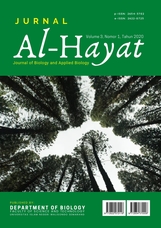Long-Tailed Macaques (Macaca fascicularis) and Humans Interactions in Grojogan Sewu Natural Park (TWA GS), Karanganyar Regency, Central Java Province
Main Article Content
Abstract
Macaca fascicularis is one species of primate that easily adapts to various habitats, such as disturbances habitat, like a natural park. The conflict between M. fascicularis and human increases due to changes in ecology. In Borneo, Sumatra, Malaysia, Mauritus, and Thailand, M. fascicularis has become pests because destroyed orchards and plantations. Interaction between M. fascicularis and human, which occurred at several natural parks in Singapura and Kaliurang caused by M. fascicularis’s attraction to food brought by humans. This research aimed to study the interaction between M. fascicularis with the humans in Grojogan Sewu Natural Park (TWA GS) by direct observation and also an interview with visitors, workers, and villagers. Based on direct observation, frequency of affiliation interaction between humans and M. fascicularis (55.56%) is higher than agonistic interaction (44.4%). The dominant affiliation interaction was sitting nearby the visitors (42.96%); meanwhile, the most dominant agonistic interaction was stealing (54.12%) because the M. fascicularis attracted to food (67.02%). Workers reported having more nuisance problem with M. fascicularis than visitors and villagers. Almost all of the respondents thought that M. fascicularis needs to be kept alive in the park, and consider conservation and protection of the macaques are essential.
Downloads
Article Details
The copyright of the received article shall be assigned to the journal as the publisher of the journal. The intended copyright includes the right to publish the article in various forms (including reprints). The journal maintains the publishing rights to the published articles. Authors are allowed to use their articles for any legal purposes deemed necessary without written permission from the journal with an acknowledgment of initial publication to this journal.
The work under license Creative Commons Attribution-ShareAlike 4.0 International License.
References
Altman J. 1974. Observational Study of Behaviour: Sampling Methods. Chicago (US): University of Chicago.
Djuwantoko, Retno NU, Wiyono. 2008. Interaksi agresif monyet, Macaca fascicularis (Raffles, 1821) terhadap wisatawan di hutan wisata alam kaliurang, Yogyakarta. Biodiversitas. 9(4): 301-305.
Fakhri H. 2012. Studi awal populasi dan distribusi Macaca fascicularis di Cagar Alam Ulolanang Raffles. [skripsi]. Semarang (ID): Universitas Negeri Semarang.
Fooden J. 1995. Systematic review of Southeast Asian long tail macaques, Macaca fascicularis. Field Zool. New series (81): 1- 20.
Fuentes A. 2006. Human culture and monkey behaviour: assessing the context of potential pathogen transmission between macaques and humans. Am J Primatol. 68: 880- 896.
Fuentes A, Shaw E, Cortes J. 2007. Qualitative assessment of macaques tourist sites in Padangtegal Bali, Indonesia and the upper rock nature reserve, Gibraltar. Int J Primatol. 28: 1143- 1158.
Gumert MD, Fuentes A, and Jones Engel L.2011. Monkey on The Edge: Ecology and Management of Long- Tailed Macaques and Their Interface with Humans. New York (US): Cambridge University Press.
Hambali K, Ismail A, Zulkifli SZ, MD-Zain BM, Anuar A. 2012. Human- macaque conflict and pest behaviour of long tailed macaques (Macaca fascicularis) in Kuala Selangor Natural Park. TNH. 12(2): 189-205.
Hardin CM. 2015. Macaca fascicularis- human interaction in Telaga Warna, Bogor, West Java. [skripsi]. Bogor (ID): Institut Pertanian Bogor.
Lee PC, Priston NEC. 2005. Human Attitudes to Primates: Perceptions of Pests, Conflict and Consequences for Primate Conservation. In: Paterson JD, Wallis J, Editors. Commensalism and Conflict : The Human Primate Interface. Norman, Oklahama: American Society of Primatology. P: 1-23.
Perveen F, Karimullah, Anuar S. 2014. Long-tailed macaques, Macaca fascicularis (primate: Cercopithecidae) : human-monkey behavioural interaction in Botanical Garden Penang, Malaysia. Annals Exp Biol. 2(1): 36-44.
Rinaldi D. 1992. The use of triangel and concentration count methods in the investigation of gibbon distribution and population. Media Konser. 4: 9-21.
Rocha LC, Fortes VB. 2015. Perceptions and attitudes of rural residents towards capuchin monkey, in the area of influence of the Dona Francisca Hydroelectric Power Plant, South Brazil. Amb n Soc. 18 (4): 19-34.
Sha JCM, Gumert MD, Lee BPYH, Engel LJ, Chan S, Fuentes A. 2009. Macaque- human interactions and the social perception of macaques in Singapore. Am J Primatol. 71: 825-839.
Siswantoro H, Sutrisno A, Dwi PS. 2012. Strategi optimasi wisata massal di kawasan konservasi taman wisata alam Grojogan Sewu. J Ilmu Lingk. 10 (2): 100-116.
Wheatley BP. 1980. Feeding and Ranging of East Bornean Macaca fascicularis. New York (US): Van Nostrand Reinhold co. pp:215-246.

